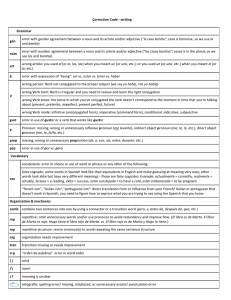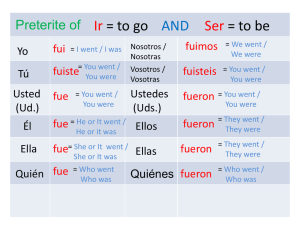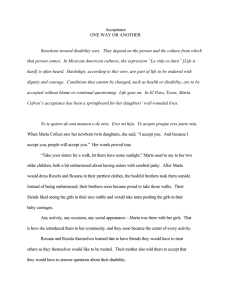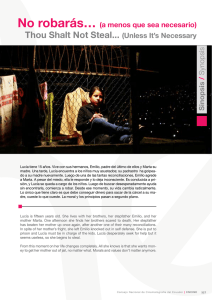complete paper - Cascadilla Proceedings Project
Anuncio
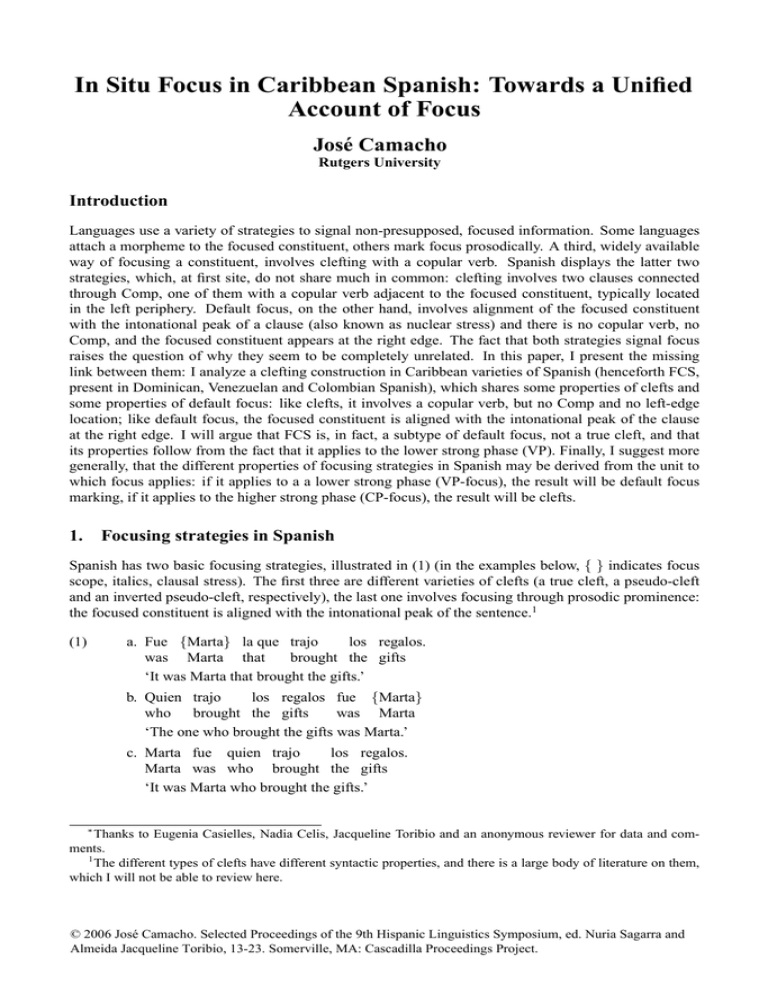
In Situ Focus in Caribbean Spanish: Towards a Unified
Account of Focus
José Camacho
Rutgers University
Introduction
Languages use a variety of strategies to signal non-presupposed, focused information. Some languages
attach a morpheme to the focused constituent, others mark focus prosodically. A third, widely available
way of focusing a constituent, involves clefting with a copular verb. Spanish displays the latter two
strategies, which, at first site, do not share much in common: clefting involves two clauses connected
through Comp, one of them with a copular verb adjacent to the focused constituent, typically located
in the left periphery. Default focus, on the other hand, involves alignment of the focused constituent
with the intonational peak of a clause (also known as nuclear stress) and there is no copular verb, no
Comp, and the focused constituent appears at the right edge. The fact that both strategies signal focus
raises the question of why they seem to be completely unrelated. In this paper, I present the missing
link between them: I analyze a clefting construction in Caribbean varieties of Spanish (henceforth FCS,
present in Dominican, Venezuelan and Colombian Spanish), which shares some properties of clefts and
some properties of default focus: like clefts, it involves a copular verb, but no Comp and no left-edge
location; like default focus, the focused constituent is aligned with the intonational peak of the clause
at the right edge. I will argue that FCS is, in fact, a subtype of default focus, not a true cleft, and that
its properties follow from the fact that it applies to the lower strong phase (VP). Finally, I suggest more
generally, that the different properties of focusing strategies in Spanish may be derived from the unit to
which focus applies: if it applies to a a lower strong phase (VP-focus), the result will be default focus
marking, if it applies to the higher strong phase (CP-focus), the result will be clefts.
1.
Focusing strategies in Spanish
Spanish has two basic focusing strategies, illustrated in (1) (in the examples below, { } indicates focus
scope, italics, clausal stress). The first three are different varieties of clefts (a true cleft, a pseudo-cleft
and an inverted pseudo-cleft, respectively), the last one involves focusing through prosodic prominence:
the focused constituent is aligned with the intonational peak of the sentence.1
a. Fue {Marta} la que trajo
los regalos.
was Marta that
brought the gifts
‘It was Marta that brought the gifts.’
(1)
b. Quien trajo
los regalos fue {Marta}
who brought the gifts
was Marta
‘The one who brought the gifts was Marta.’
c. Marta fue quien trajo
los regalos.
Marta was who brought the gifts
‘It was Marta who brought the gifts.’
∗
Thanks to Eugenia Casielles, Nadia Celis, Jacqueline Toribio and an anonymous reviewer for data and comments.
1
The different types of clefts have different syntactic properties, and there is a large body of literature on them,
which I will not be able to review here.
© 2006 José Camacho. Selected Proceedings of the 9th Hispanic Linguistics Symposium, ed. Nuria Sagarra and
Almeida Jacqueline Toribio, 13-23. Somerville, MA: Cascadilla Proceedings Project.
14
d. Los trajo
{Marta}
Marta
CL brought
‘{Marta} brought gifts.’
All clefts share three properties: they involve two clauses, one of them headed by a copular verb; they
join those two clauses through Comp, and the copular clause is peripheral with respect to the main clause.
Typically, clefts and inverted pseudo-clefts , such as (1a, c) place the focused constituent at the the right
edge of the main clause, whereas pseudo-clefts, such as (1b) locate at the right edge. In (1d), focus is
signaled through nuclear peak alignment and most of the properties of clefts do not hold: there is only one
clause, hence there is no copular verb and no Comp, and, like pseudo-clefts, the focused constituent is at
the right edge. One obvious question one can ask is why there are such apparently divergent strategies
for focus. In order to begin to answer this question, I will look at a fifth kind of focus construction, found
in the Caribbean region (henceforth FCS), which resembles clefts because it has a copular verb, but lacks
Comp and is necessarily right-edge aligned.
FCS marks identificational focus (i.e., focus in which the speaker exhaustively identifies an alternative to a given item in an preceding clause or in the discourse) by placing a copular verb in front of the
focused constituent, as illustrated in (2) (cf. Sedano 1988a, b, 1990, Toribio 1992, 2002, Bosque 1999).
Different types of constituents can be focused: a postverbal subject (cf. (2a)), an indirect object PP (cf.
(2b)), a direct object (cf. (2c)), a predicate adjective (cf. (2d)), an adverb (cf. (2e)), and even DP-internal
constituents such as NPs, as in (2f).
a. Compró los libros fue {Pedro}.
bought the books was Pedro
‘It was Pedro who bought the books.’
(2)
b. El gobierno
le cedió
terrenos fue a {las multinacionales}.
the government CL granted land
was to the transnationals
‘It was transnational corporations that the government granted land to.’
c. Los bomberos rescataron fue a {la abuela}.
the firefighters rescued
was to the grandmother
‘It was the grandmother the firefighters rescued.’
d. Mi hermano estaba era {triste}.
my brother was
was sad
‘It was sad that my brother was.’
e. Llegamos fue {ayer}.
arrived
was yesterday
‘It was yesterday that we arrived.’
f. El presidente de esa época tuvo una fue {parálisis}.
was paralysis
the president of that time had a
‘It was a paralysis the president at that time had.’
The copular verb cannot modify preverbal subjects (cf. (3)). In general, it cannot modify any category
higher than vP (cf. Bosque 1999). This can be seen in the following examples: if we assume that in
Spanish, inflected verbs are in I, as indicated in (4a), the copular verb cannot modify an inflected verb
(cf. (4b)), or any other category in I: no in (5b) or a modal in (6b). However, it may modify infinitival
verbs, which can be assumed to be lower than I (cf. (7)).2 This distribution is summarized in the
generalization in (8).
a. Compró papas
fue {Juan}.
bought potatoes was Juan
‘It was Juan who bought potatoes.’
(3)
2
Node labels are simply indicative of the generalization proposed, the actual structure of the FCS will be discussed below.
15
b. *Fue {Juan} compró papas.
was Juan bought potatoes
(4)
a. [IP Marta [I0 compró [vP papas]]]
Marta bought
potatoes
‘Marta bought potatoes.’
b. *[IP Marta fue [I0 compró [vP papas]]]
Marta was
bought
potatoes
(5)
a. [NegP Marta [Neg0 no [IP compró [vP papas]]]]
Marta
not
bought
potatoes
‘Marta did not buy potatoes.’
b. *[NegP Marta fue [Neg0 no [IP compró [vP papas]]]]
Marta was
not
bought
potatoes
(6)
a. [IP/ModP Marta [I0 /Mod0 pudo [vP comprar papas]]]
Marta
could
buy
potatoes
‘Marta could buy potatoes.’
b. *[IP/ModP Marta fue [I0 /Mod0 pudo [vP comprar papas]]]
Marta was
could
buy
potatoes
(7)
a. [IP/ModP Marta [I0 /Mod0 pudo fue [vP comprar papas]]]
Marta
could was
buy
potatoes
‘It was buying potatoes that Marta could do.’
b. [IP Marta [I0 prometió fue [vP comprar papas]]]
Marta promised was
buy
potatoes
‘It was promising to buy potatoes that Marta could do.’
(8)
In FCS, the copular verb only takes vP-internal constituents in its scope.
Consistent with this generalization, only vP-internal adverbs can be focused in FCS. Thus, francamente ‘frankly’ which is ambiguous between a speech-oriented and a VP-internal interpretation, only
receives the vP-internal, manner interpretation in (9), not the speech-oriented one.
(9)
Marta no deberı́a hablar es francamente.
Marta not should talk
is frankly
‘It is frankly that Marta should not talk.’
Finally, FCS cannot appear with Comp, as seen in (10), a fact that also falls within the generalization
in (8): if Comp is a category projected above IP, it follows that it should not appear in the scope of the
copular verb in FCS.
(10)
*Marta trajo
fue que un libro.
Marta brought was that a book
Partially based on the distribution just described, Bosque (1999) proposes the structure in (11): the
focus projection, headed by the copular verb, appears between IP and vP (VP in his terminology). If
we assume this structure, the properties described above follow: the only categories within the scope of
the copular verb should be vP-internal ones: internal arguments, vP-adverbs, postverbal subjects, but not
I-related categories (an inflected verb, modals, negation), or preverbal subjects (assuming they are higher
than vP).
16
(11)
IP
Q
Q
Q
I
FocP
Q
Q
Q
fue
vP
Q
Q
Q
Toribio (1992, 2002) proposes an alternative analysis based on the idea that FCS is a version of a
pseudo-cleft, but with a null wh-operator, as in (12). Bosque, however, points out that Toribio’s (1992)
version of the analysis predicts that subjects should not be possible with FCS, because the trace of the
null operator is not properly identified. However, in Sedano’s corpus and in other dialects, postverbal
subjects are, indeed possible (cf. (2a) above). There seems to be a source of dialectal variation at
stake in this particular aspect, since postverbal subjects are dispreferred in general in Dominican Spanish
(Toribio, p.c.), hence (1d) would be deviant in this dialect (as pointed out by an anonymous reviewer) ,
which would account for why subjects are not possible in general with FCS in that dialect; but clearly,
extending her analysis to other dialects where FCS is possible with postverbal subjects is problematic.
(12)
a. Pseudo-cleft: [A quienwh yo vi twh ] fue a Marta
b. FCS: [ Opwh yo vi twh ] fue a Marta
There are other areas in which FCS does not pattern like pseudo-clefts, as Bosque points out, suggesting that they have different structures. For example, superlative constructions can be pseudo-clefted,
but are not possible with FCS, as shown in (13)-(14).
(13)
a. Lo que le gusta
es bailar salsa.
what
CL pleases is dance salsa
‘What s/he likes is to dance salsa.’
b. Le gusta
es bailar salsa.
CL pleases is dance salsa
‘It’s dancing salsa that he likes.’
(14)
a. Lo que más le gusta
es bailar salsa.
what
most CL pleases is dance salsa
‘What s/he likes most is to dance salsa.’
b. *Más le gusta
es bailar salsa.
most CL pleases is dance salsa
Additionally, wh-extraction out of a pseudo-cleft is possible, but not out of FCS, as shown below.
This is unexpected if they involve the same type of structure, and particularly striking, since as Toribio
points out, wh-extraction from clefts is a very productive structure in Dominican Spanish, as seen in (16)
(Toribio’s example (7c)).
(15)
a. ¿Qué era lo que Juan leı́a?
what was what Juan read
‘What was it that Juan read?’
b. *¿Qué Juan leı́a era?
what Juan read was
(16)
¿Quéi es ti lo que ese muchacho me trae?
that
that boy
what is
CL brings
‘What is it that that boy is bringing me?’
17
In order to sustain Toribio’s approach one would have to argue that the overt and null operators in
(12) have very different syntactic properties. However, it is not clear what kind of difference that could
be traced to the overt or null nature of the operator would account for the contrasts we have just reviewed
(as well as others Bosque points out).
Given the preceding discussion, I will assume Bosque’s conclusion that FCS is structurally different
from pseudo-clefts. I will also assume that it focuses only constituents inside vP, and I will take this
as indication that the copular verb only merges with vP- internal constituents, although I will argue that
Bosque’s structure in (11) above cannot be exactly right.
2.
More on the structure of FCS
Recall that in Bosque’s proposal in (11) above, the copular verb selects for a vP. However, there is
some independent evidence that this cannot be the right structure. Regular arguments of a verb can be
freely extracted from their base position (cf. (17a)), but extraction of the focused constituent in FCS is
impossible (cf. (17b)).3
(17)
a. ¿Quéi se comieron los pájaros ti ?
the birds
what CL ate
‘What did the birds eat?
b. *¿Quéi se comieron los pájaros fue ti ?
the birds
was
what CL ate
This contrast can be explained in two ways. One would trace it to the presence of the copular verb,
arguing that it blocks extraction from the focus position, but it is not generally the case that extraction
from copular constructions, or even extraction from within clefts is ungrammatical, as seen in (18)(19). Alternatively, one can propose that (17)a and b have structurally different representations. In
this analysis, the trace of the extracted constituent in (17b) is not the argument of the verb, but rather
an adjunct. As is well-known, extraction from adjuncts is ungrammatical, as opposed to extraction from
argument clauses, as seen in (20)-(21). If the copular structure is adjoined, the ungrammaticality of (17b)
follows from whatever principle restricts extraction from adjuncts (what used to be the Empty Category
Principle).
(18)
a. Eso es un ratón.
those is a mouse
‘That is a mouse’
b. ¿Quéi es eso ti ?
what is that
‘What is that?’
3
Toribio’s alternative correctly predicts that extraction from FCS should pattern with extraction from pseudoclefts, as shown by the ungrammaticality of (i). Toribio’s analysis still faces the other challenges presented earlier.
Note that the version in (ii) is possible, but it is not clear whether the relevant source for it is a pseudo-cleft, or a true
cleft. In any event, note that the parallel to (ii) with FCS is ungrammatical. Thanks to Eugenia Casielles for pointing
this out.
i. *¿Qué lo que se comieron los pájaros fue ti ?
what what CL ate
the birds was
ii. ¿Qué fue lo que se comieron los pájaros?
what was what CL ate
the birds
iii. *¿Qué fue se comieron los pájaros?
what was CL ate
the birds
18
(19)
a. Fue/fueron las migas lo que los pájaros se comieron.
was/were the crumbs that
the birds
CL ate
‘It was the crumbs that the birds ate.’
b. ¿Quéi ti fue lo que se comieron los pájaros.
was that
the birds
what
CL ate
‘What was it that the birds ate?’
(20)
a. Mirta fue a Parı́s antes de conocer a Paula.
Mirta went to Paris before of knowing to Paula
‘Mirta went to Paris before of meeting Paula’
b. ¿*A quién fue Mirta a Parı́s antes de conocer ti ?
to whom went Mirta to Paris before of knowing
(21)
a. Mirta le pidió que llamara a Paula.
Mirta CL asked that call
to Paula
‘Mirta asked him/her to call Paula’
b. ¿A quién le pidió Mirta que llamara ti ?
to whom CL asked Mirta that called
‘Who did Mirta ask him/her to call?
Further evidence that the focused constituent is not in an argumental position comes from (22a),
where the overt object las migas ‘the crumbs’ can appear inside an island. If we assume that arguments
must be assigned theta roles under sisterhood, (22a) suggests that las migas ‘the crumbs’ cannot be
the argument of comió ‘ate’, because it is not its sister. Rather, I will propose the alternative structure
in (22b), with a null category in argument position coindexed with the predicate of the copular verb.
However, there is no movement relation between the overt las migas ‘the crumbs’ and the null category
in the main clause. Note that the corresponding pseudo-cleft is ungrammatical (cf. (22c)), suggesting,
once again, that FCS is not a pseudo-cleft (thanks to Eugenia Casielles for this observation).
(22)
a. El pájaro se comió me sorprende el hecho de que fuera/fueran las migas.
the birds CL ate
of that was/were
the crumbs
CL surprises the fact
‘The birds ate, I am surprised about the fact that it was the crumbs.’
b. El pájaro se comió ei [me sorprende el hecho de que fuera/fueran las migasi ]
c. *Lo que se comieron los pájaros me sorprende el hecho de que fueran las
what
the birds
of that were the
CL ate
CL surprises the fact
migas.
crumbs
To present a more detailed structure of FCS, I assume that the copular verb in FCS has the same
minimal structural and argumental properties as other copular verbs: a subject and a predicate, and the
structure in (23). In the FCS, the copular structure is an adjunct to VP, as in (24). Here, the CopP is
an equative structure, whose subject is null and whose predicate is the focused DP. The argument of the
main verb is null, and it is coindexed with the null subject of the copular verb.
(23)
IP
HH
H
H
XPSUBJ
I0
HH
H
I
YPPRED
19
(24)
IP
H
HH
H
los pájaros
I0
HH
se comieron
H
H
VP
PP
PP
P
P
VP
H
HH
V
ei
IPCOP
H
HH
x
I0COP
HH
H
fue
las migasi FOC
In this analysis, FCS crucially differs from pseudo-clefts and inverted pseudo-clefts in that the latter two
involve a CP, but the former does not, as seen by comparing (24) with (25) below. Hence, FCS does not
require (and cannot have) a complementizer, whereas pseudo-clefts and inverted pseudo-clefts must have
a complementizer: the corresponding sentences to (25a-b) without lo que are ungrammatical (as pointed
out by Eugenia Casielles, p.c.)
(25)
a. Fue las migas [CP lo que se comieron los pájaros]
b. Las migas fue [CP lo que se comieron los pájaros]
This structure directly maps to the LF proposed for focus by Zubizarreta (1998), following Chomsky
(1971, 1976) and Jackendoff (1972). In this proposal, a clause containing a focused constituent such as
(26a) has the assertion structure in (26b). The first part of this assertion structure is presupposed, and
contains a variable in place of the focused constituent; the second part identifies that variable through an
equative clause. As suggested, the assertion structure in (26b) maps directly to the syntactic structure
proposed in (24): the higher part of the tree denotes the presupposed clause los pájaros se comieron x
‘birds ate x’, and the adjoined structure provides the equative part x = migas ‘x = crumbs’.
(26)
a. John bought potatoes
b. John bought x & the x that John bought = potatoes
This proposed syntactic structure makes the following prediction: when the focused constituent (the
predicate of the copular verb) is a quantifier, it should not take scope over any argument in the main
clause, since it is not only structurally lower, but also inside an adjoined constituent. As expected,
(27a) only allows for a narrow scope interpretation of the universal quantifier cada with respect to the
indefinite subject, cf. (28b). This contrasts with similar examples without the copular verb, where both
scope relations are possible, as seen in (cf. (28)).
(27)
a. Un niño se comió fue cada manzana.
a
boy CL ate
was each apple
‘it was each apple that a boy ate’
b. A single boy ate each of the apples (narrow scope ∀)
(28)
a. Un niño se comió cada manzana.
a
boy CL ate
each apple
‘A boy ate each apple’
b. For each apple there was a different boy that ate (wide scope ∀)
c. A single boy ate each of the apples (narrow scope ∀)
20
3.
The single-constituent requirement for FCS
The syntactic structure and semantic analysis just proposed can also explain another property of FCS that
does not readily follow from Bosque’s proposal: the fact that there can only be a single constituent after
the copular verb, as seen in (29a). If there is more than one to the right of the copular verb, the result is
ungrammatical regardless of which constituent is focused, as seen in (29b-d). The relevant generalization
for these examples is given in (30).4
(29)
a. Marta le compró pan
fue [VP a {su abuela}]
Marta CL bought bread was
to her grandmother
‘It was her grandmother that Marta bought bread for.’
b. *Marta le compró fue [VP {pan} a su abuela]
Marta CL bought was
bread to her grandmother
c. *Marta le compró fue [VP pan
a {su abuela}]
Marta CL bought was
bread to her grandmother
d. *Marta le compró fue [VP {pan
a su abuela}]
(no galletas a su
Marta CL bought was
bread to her grandmother not cookies to her
hermana)
sister
(30)
FCS affects a single, domain-final constituent in the relevant domain (typically the clause).
This restriction can be accounted for as follows: any constituent that appears to the right of the
copular verb must be interpreted as part of the identificational predicate of that verb, hence its argument
position must be a variable, as in (31), the representation for (29d) above. However, the null subject of
the equative clause (x) must identify both of the variables in argument position, and, at the same time, be
identified through the predicate of the copular verb. Since the antecedents (ec em ) do not form a single
constituent, presumably, the null subject of the copular verb cannot identify the arguments of the main
verb.
(31)
Marta le compró ec em [IP−cop x fue pan
a su abuela]
Marta CL bought
was bread to her grandmother
It is an independent property of copulative clauses that they cannot involve two independent constituents as predicates, unless they are non-conjoined (in which case, they can be argued to be a single
constituent) as seen in (32).5
(32)
a. Ellos son el hermano y
la hermana.
they are the brother and the sister
‘They are the brother and the sister.’
b. *Ellos son el hermano para/de la hermana.
they are the brother for/of the sister
c. Eso es para/de la hermana.
that is for/of the sister
‘That is for/of the sister.’
4
Since FCS can appear DP-internally (cf. ex. (2f) above), (30) is formulated as generally as possible, for our
present purposes, the copular verb takes the last constituent in the clause.
5
As Eugenia Casielles has pointed out to me, the restrictions in (29) also apply to other types of clefts, and I
believe the analysis proposed can be extended to them, all clefts share in common the presence of a copular verb.
21
4.
Nuclear peak-aligned focus. P-movement
One final question to be addressed is why the focused constituent must be domain final (the second part of
(30)). Several authors (Contreras 1976, Fant 1984, Zubizarreta 1998, Face 2002) have argued that focus
is aligned with the prosodic peak of the clause, which in Spanish, is the lowest c-commanded argument
in it, typically the one on right edge (cf. Zubizarreta 1998). Zubizarreta formalizes this observation in
the Focus-Prosody Correspondence Principle in (33).
(33)
Focus-Prosody Correspondence Principle (FPCP)
The focused constituent (or F-marked constituent) of a phrase must contain the intonational
nucleus of that phrase.
According to Zubizarreta, if a focused constituent is in a position where nuclear stress is not assigned
(i.e. it is not final), a p(rosodically)-motivated movement realigns constituents so that focus and nuclear
stress are mapped to the same constituent. For example, if the context requires narrow focus on the
subject, the constituents to the right of the subject will move, yielding the order VOS, as in (34)-(35),
where the lower VP adjoins to the higher VP, according to Zubizarreta.
(34)
Perdió un anillo {Miguel}
lost
a ring
Miguel
‘{Miguel} lost a ring’
(35)
IP
H
HH
H
perdió
I0
HH
H
H
VP1
PPP
P
P
VP2
Q
Q
Q
un anillo
o
VP1
PP
P
Miguel
V01
PP
P
tv
t
In the case of FCS, the focused constituent must also receive the intonational peak of the clause. If
focus and intonational peak are not aligned, the result is ungrammatical, as seen in (36), where focus is
on camiseta ‘T-shirt’ and stress on Marta. This suggests that FCS is also subject to the FPCP in (33)
above.
(36)
*Le regalaron fue una {camiseta} a Marta.
was a
T-shirt
to Marta
CL gave
The main difference between (exclusively) peak-aligned focus and FCS is that the former involves
presentational focus, whereas the latter denotes exhaustive focus, as the following tests, proposed by
Kiss (1998), suggest. The first test rests on the following idea: if a sentence with a conjoined, focused
DP is contradicted by the same sentence with only one of the focused conjuncts, then focus is exhaustive,
because the first clause exhausts the set of alternatives, and the second contradicts the exhaustive choice
of alternatives offered by the first clause.
If we apply this test to FCS, (37b) is contradictory with respect to (37a), as expected if FCS exhausts
the set of alternatives. The second test involves denying the content of the focused constituent in one
sentence, as in (38). If the second clause is a possible continuation to the first one, the first one involves
22
exhaustive focus, because it denies the exhaustive nature of the set of alternatives. If focus is presentational, the set is not exhaustive, hence a continuation that denies such exhaustivity is not felicitous.
As (38) shows, FCS patterns with exhaustive focus in this test, as do other clefts, whereas peak-aligned
focus is presentational.
(37)
a. Compraron un carro hı́brido fueron {Marta y
Miguel}
bought
a car
hybrid was
Marta and Miguel
‘It was Marta and Miguel who bought a hybrid car.’
b. Compró un carro hı́brido fue {Marta}
bought a car
hybrid was Marta
It was Marta who bought a hybrid car.’
(38)
a. Miguel perdió fue un {anillo}
Miguel lost
was a
ring
‘It was ring that Miguel lost.’
b. No, Miguel también perdió un arete
no, Miguel also
lost
an earring
‘No, Miguel also lost an earring.’
These facts suggest a division of labor in which focus marking in FCS is done through nuclear stress
alignment, whereas exhaustivity is added by the copular verb. The fact that FCS is subject to FPCP
explains why the constituent associated with the copular verb must be clause-final: it must receive the
intonational peak of the clause, hence the ungrammaticality of (36), where the focused constituent does
not receive it.
5.
One focus, two locations
To summarize the analysis, I have argued that FCS involves assigning focus to a constituent by aligning it
with the clausal stress position (as in the case of a pseudo-cleft). Syntactically, FCS involves two clauses,
one with a variable (corresponding to the constituent that is focused) and interpreted as a presupposition;
and a second clause adjoined to VP, headed by a copular verb, that takes a null resumptive pronoun
(coindexed with the variable), and the focused constituent as its predicate. By virtue of being a copular
structure, the null resumptive pronoun is equated with the predicate, and, in turn, identifies the variable
in argument position.
We can now return to the general typology of focus constructions presented at the beginning of this
paper. Most traditional clefts are not aligned with intonational peak of the main clause, since they are to
the left of that clause. Additionally, they are attached to the higher projections of that clause, rather than
the vP projections, as FCS has been argued to be. Focus structures are given in (39).
(39)
Clefts (CP-focus)
CopP
Q
Q
XPFoc
Cop0
Q
Q
Q
Cop
CP
Q
Q
FCS (VP-focus)
VP
Q
QQ
VP
CopP
Q
QQ
XPFoc
Nuclear stress-assigned
focus (VP-focus)
VP
Q
QQ
V
XPFoc
In the first structure, the copular phrase is merged with a CP, in FCS, the copular phrase is merged
with VP, and its predicated must align with the clausal stress position, in the third one, the focused
constituent is also aligned with the clausal stress position. Thus, the scope domain for focus is CP or
VP, what Chomsky (2000, 2001) has called a strong phase. We can conclude that the domain of focus
is a strong phase, as expected if strong phases are the minimal interface units, and focus is an interface
category.
23
References
Ignacio Bosque. Sobre la estructura sintáctica de una construcción focalizadora. In Homenaje a D. Ambrosio
Rabanales. Universidad de Chile, Santiago de Chile, 1999.
Noam Chomsky. Deep structure, surface structure and semantic interpretation. In D. Steimberg and L. Jakobovits,
editors, Semantics: An Interdisciplinary Reader in Philosophy, Linguistics and Psychology. Cambridge University Press, Cambridge, 1971.
Noam Chomsky. Conditions on rules of grammar. Linguistic Analysis, 3:303–351, 1976.
Noam Chomsky. Minimalist inquiries: The framework. In Roger Martin, David Michaels, and Juan Uriagereka,
editors, Step by Step: Essays on Minimalist Syntax in Honor of Howard Lasnik, pages 89–156. MIT Press, 2000.
Noam Chomsky. Derivation by phase. In Michael Kenstowicz and Samuel Keyser, editors, Ken Hale: A Life in
Language, pages 1–52. MIT Press, 2001.
Heles Contreras. A Theory of Word Order. North Holland, Amsterdam, 1976.
Timothy Face. Intonational Marking of Contrastive Focus in Madrid Spanish. Lincom Europa, München, 2002.
Lars Fant. Estructura Informativa En Español: Estudio Sintáctico Y Entonativo. PhD thesis, Uppsala University.,
1984.
Ray Jackendoff. Gapping and related rules. Linguistic Inquiry, 2:21–35, 1972.
Katalin É. Kiss. Identificational focus versus information focus. Language, 74:245–273, 1998.
Mercedes Sedano. Presencia o ausencia de relativo: Explicaciones funcionales. Amsterdam, 1988a. 45 Congreso
Internacional de Americanistas.
Mercedes Sedano. Yo vivo es en caracas: Un cambio lingüı́stico. In M. R. Hammond and M. C Resnick, editors, Studies in the Caribbean Spanish Dialectology, pages 115–123. Georgetown University Press, Washington,
1988b.
Mercedes Sedano. Hendidas y otras construcciones con ser en el habla de caracas. Cuadernos del Instituto de
Filologı́a Andrés Bello, 1990.
Almeida Jacqueline Toribio. Proper government in spanish subject relativization. Probus, 4:291–304, 1992.
Almeida Jacqueline Toribio. Focus on clefts in dominican spanish. In James Lee, K. Geeslin, and J.C. Clements,
editors, Structure, Meaning, and Acquisition in Spanish, pages 130–146. Cascadilla Press, 2002.
Maria Luisa Zubizarreta. Prosody, Focus, and Word Order. MIT Press, Cambridge, Mass., 1998.
Selected Proceedings of the
9th Hispanic Linguistics Symposium
edited by Nuria Sagarra
and Almeida Jacqueline Toribio
Cascadilla Proceedings Project
Somerville, MA
2006
Copyright information
Selected Proceedings of the 9th Hispanic Linguistics Symposium
© 2006 Cascadilla Proceedings Project, Somerville, MA. All rights reserved
ISBN 1-57473-413-X library binding
A copyright notice for each paper is located at the bottom of the first page of the paper.
Reprints for course packs can be authorized by Cascadilla Proceedings Project.
Ordering information
Orders for the library binding edition are handled by Cascadilla Press.
To place an order, go to www.lingref.com or contact:
Cascadilla Press, P.O. Box 440355, Somerville, MA 02144, USA
phone: 1-617-776-2370, fax: 1-617-776-2271, e-mail: [email protected]
Web access and citation information
This entire proceedings can also be viewed on the web at www.lingref.com. Each paper has a unique document #
which can be added to citations to facilitate access. The document # should not replace the full citation.
This paper can be cited as:
Camacho, José. 2006. In Situ Focus in Caribbean Spanish: Towards a Unified Account of Focus. In Selected
Proceedings of the 9th Hispanic Linguistics Symposium, ed. Nuria Sagarra and Almeida Jacqueline Toribio,
13-23. Somerville, MA: Cascadilla Proceedings Project.
or:
Camacho, José. 2006. In Situ Focus in Caribbean Spanish: Towards a Unified Account of Focus. In Selected
Proceedings of the 9th Hispanic Linguistics Symposium, ed. Nuria Sagarra and Almeida Jacqueline Toribio,
13-23. Somerville, MA: Cascadilla Proceedings Project. www.lingref.com, document #1362.
